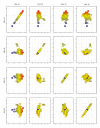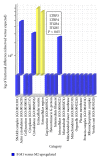Transforming growth factor-beta (TGF- β) signaling in paravertebral muscles in juvenile and adolescent idiopathic scoliosis
- PMID: 25313366
- PMCID: PMC4181945
- DOI: 10.1155/2014/594287
Transforming growth factor-beta (TGF- β) signaling in paravertebral muscles in juvenile and adolescent idiopathic scoliosis
Abstract
Most researchers agree that idiopathic scoliosis (IS) is a multifactorial disease influenced by complex genetic and environmental factors. The onset of the spinal deformity that determines the natural course of the disease, usually occurs in the juvenile or adolescent period. Transforming growth factors β (TGF-βs) and their receptors, TGFBRs, may be considered as candidate genes related to IS susceptibility and natural history. This study explores the transcriptional profile of TGF-βs, TGFBRs, and TGF-β responsive genes in the paravertebral muscles of patients with juvenile and adolescent idiopathic scoliosis (JIS and AIS, resp.). Muscle specimens were harvested intraoperatively and grouped according to the side of the curve and the age of scoliosis onset. The results of microarray and qRT-PCR analysis confirmed significantly higher transcript abundances of TGF-β2, TGF-β3, and TGFBR2 in samples from the curve concavity of AIS patients, suggesting a difference in TGF-β signaling in the pathogenesis of juvenile and adolescent curves. Analysis of TGF-β responsive genes in the transcriptomes of patients with AIS suggested overrepresentation of the genes localized in the extracellular region of curve concavity: LTBP3, LTBP4, ITGB4, and ITGB5. This finding suggests the extracellular region of paravertebral muscles as an interesting target for future molecular research into AIS pathogenesis.
Figures






Similar articles
-
Vitamin D receptor gene (VDR) transcripts in bone, cartilage, muscles and blood and microarray analysis of vitamin D responsive genes expression in paravertebral muscles of juvenile and adolescent idiopathic scoliosis patients.BMC Musculoskelet Disord. 2012 Dec 23;13:259. doi: 10.1186/1471-2474-13-259. BMC Musculoskelet Disord. 2012. PMID: 23259508 Free PMC article.
-
Asymmetric expression of H19 and ADIPOQ in concave/convex paravertebral muscles is associated with severe adolescent idiopathic scoliosis.Mol Med. 2018 Sep 18;24(1):48. doi: 10.1186/s10020-018-0049-y. Mol Med. 2018. PMID: 30241458 Free PMC article.
-
Increased expression of collagens, transforming growth factor-beta1, and -beta3 in gluteal muscle contracture.BMC Musculoskelet Disord. 2010 Jan 25;11:15. doi: 10.1186/1471-2474-11-15. BMC Musculoskelet Disord. 2010. PMID: 20100316 Free PMC article.
-
TGF-beta: from latent to active.Microbes Infect. 1999 Dec;1(15):1255-63. doi: 10.1016/s1286-4579(99)00259-2. Microbes Infect. 1999. PMID: 10611753 Review.
-
The transforming growth factor-betas: structure, signaling, and roles in nervous system development and functions.J Neurochem. 2000 Dec;75(6):2227-40. doi: 10.1046/j.1471-4159.2000.0752227.x. J Neurochem. 2000. PMID: 11080174 Review.
Cited by
-
Unique local bone tissue characteristics in iliac crest bone biopsy from adolescent idiopathic scoliosis with severe spinal deformity.Sci Rep. 2017 Jan 5;7:40265. doi: 10.1038/srep40265. Sci Rep. 2017. PMID: 28054655 Free PMC article.
-
Plasma exosome proteomics reveals upregulation of CILP-1 in concave side of paraspinal muscle in adolescent idiopathic scoliosis.Clin Proteomics. 2025 Jun 3;22(1):23. doi: 10.1186/s12014-025-09542-8. Clin Proteomics. 2025. PMID: 40461962 Free PMC article.
-
Upregulation of cGMP-dependent Protein Kinase (PRKG1) in the Development of Adolescent Idiopathic Scoliosis.Orthop Surg. 2020 Aug;12(4):1261-1269. doi: 10.1111/os.12694. Epub 2020 Jun 18. Orthop Surg. 2020. PMID: 32558266 Free PMC article.
-
The Potential Role of Dysregulated miRNAs in Adolescent Idiopathic Scoliosis and 22q11.2 Deletion Syndrome.J Pers Med. 2022 Nov 18;12(11):1925. doi: 10.3390/jpm12111925. J Pers Med. 2022. PMID: 36422101 Free PMC article. Review.
-
Association of FBN1 polymorphism with susceptibility of adolescent idiopathic scoliosis: a case-control study.BMC Musculoskelet Disord. 2022 May 7;23(1):430. doi: 10.1186/s12891-022-05370-1. BMC Musculoskelet Disord. 2022. PMID: 35526034 Free PMC article.
References
-
- Lowe TG, Edgar M, Marguiles JY, et al. Current concepts review. Etiology of idiopathic scoliosis: current trends in research. Journal of Bone and Joint Surgery. 2000;82(8):1157–1168. - PubMed
-
- Burwell RG, Dangerfield PH, Freeman BJC. Concepts on the pathogenesis of adolescent idiopathic scoliosis. Bone growth and mass, vertebral column, spinal cord, brain, skull, extra-spinal left-right skeletal length asymmetries, disproportions and molecular pathogenesis. Studies in Health Technology and Informatics. 2008;135:3–52. - PubMed
-
- Wang WJ, Yeung HY, Chu WC-W, et al. Top theories for the etiopathogenesis of adolescent idiopathic scoliosis. Journal of Pediatric Orthopaedics. 2011;31(1):S14–S27. - PubMed
-
- Cheng JC, Tang NL, Yeung H, Miller N. Genetic association of complex traits. Clinical Orthopaedics and Related Research. 2007;462:36–44. - PubMed
Publication types
MeSH terms
Substances
LinkOut - more resources
Full Text Sources
Other Literature Sources
Medical
Miscellaneous

